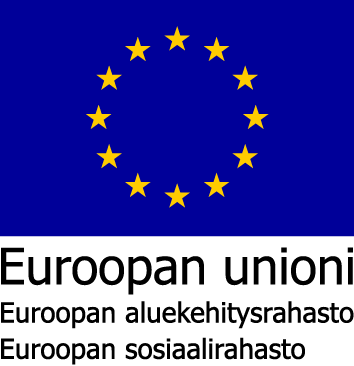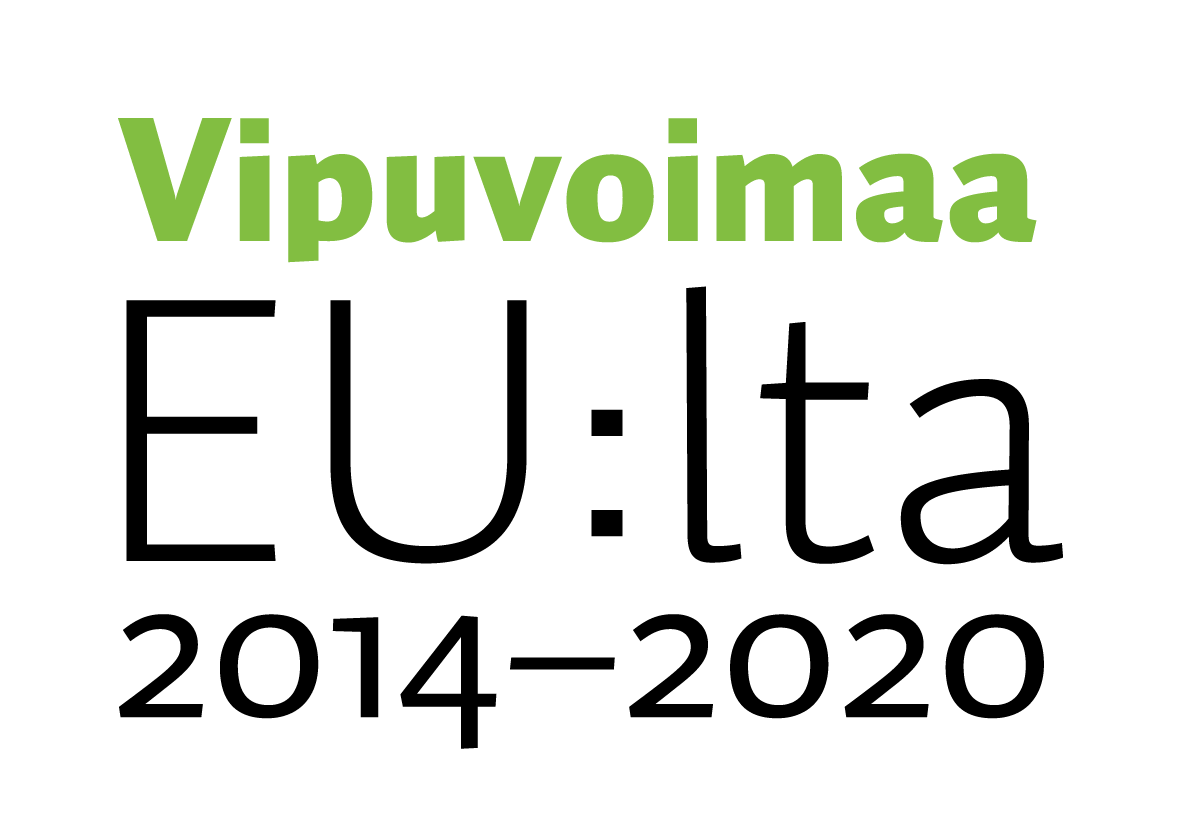

 |
 |
Hankekoodi: A77498
Hankkeen nimi: GreenGrow – pk-yritysten vihreän ja inklusiivisen kasvun tukeminen Etelä-Pohjanmaalla
Toimintalinja: 8. REACT-EU:n EAKR-toimenpiteet
Erityistavoite: 12.2. Tutkimus- ja innovaatiotoiminnan kehittäminen erityisesti digitalisaation edistämisen ja yhteiskunnan hiilineutraalisuustavoitteen toteutumisen näkökulmasta
Suunnitelman mukainen toteutusaika: Alkaa 1.8.2021 ja päättyy 31.8.2023
Toiminnan tila: Toiminta päättynyt
Vastuuviranomainen: Pirkanmaan liitto
Hakijan virallinen nimi: Seinäjoen Ammattikorkeakoulu Oy
Organisaatiotyyppi: Ammattikorkeakoulu
Y-tunnus: 2539767-3
Jakeluosoite: Kampusranta 11
Puhelinnumero: 020 1243 000
Postinumero: 60100
Postitoimipaikka: Seinäjoki
WWW-osoite: http://www.seamk.fi
Hankkeen yhteyshenkilön nimi: Pauliina Talvitie
Yhteyshenkilön asema hakijaorganisaatiossa: Tutkimus- ja kehittämispäällikkö
Yhteyshenkilön sähköpostisoite: pauliina.talvitie(at)seamk.fi
Yhteyshenkilön puhelinnumero: 0408302382
Hakijoiden lukumäärä tai tuen siirto -menettely:
Etelä-Pohjanmaalla on jo vuosia panostettu kasvuyrittäjyyden ekosysteemin kehittämiseen. Yritysten kasvu on yhteiskunnallisesti erittäin tärkeä asia, koska se luo uusia työpaikkoja sekä vaikuttaa alueen yleiseen hyvinvointiin elinvoimaisuuden, tuotteiden ja palveluiden kautta. Covid-19-pandemia on vaikuttanut merkittävästi yritysten kasvumahdollisuuksiin; osalla pandemia on vauhdittanut kasvua ja osalla vaikuttanut siihen erittäin negatiivisesti. Kasvuyrittäjyys on nähty Etelä-Pohjanmaalla perinteisesti yritysten liikevaihdon tai henkilöstön kasvuna. Jatkossa on tärkeää ottaa kasvuyrittäjyyden näkökulmiin myös vihreä ja inklusiivinen kasvu. OECD (2019) määrittelee vihreän kasvun yritysten taloudelliseksi kasvuksi, jossa samalla otetaan huomioon ympäristötavoitteet. Toisin sanoen vihreä kasvu sisältää siirtymisen resurssitehokkaaseen, hiilineutraaliin ja kestävään ympäristöresurssien käyttöön samalla, kun yritys pyrkii saavuttamaan liiketaloudelliset tavoitteensa. Inklusiivinen kasvu puolestaan tarkoittaa sitä, miten yrityksen kasvu tuottaa hyvinvointia ympärilleen omalla alueellaan. Kestävä ja inklusiivinen kasvu vaatii investointeja myös inhimilliseen pääomaan. Tällaiset investoinnit lisäävät työkykyisyyttä, työllistymistä ja tukevat työmarkkinoita ”tietopohjaisen talouden” tarpeissa, jossa työvoima on taitavaa ja joustavaa.
Vihreään siirtymä on talouden murros, johon liittyy suurta kasvupotentiaalia, mutta osaamisen puutteiden vuoksi mahdollisuuksia ei välttämättä tunnisteta eikä oikeansuuntaisia kasvua tukevia kehittämisprosesseja siten käynnistetä. Vahvistamalla yritysten kykyä tunnistaa ja hyödyntää mahdollisuudet vihreään ja inklusiiviseen kasvuun tuetaan yritysten kilpailukyvyn kehittymistä ja koko alueen elinvoimaa. Valtioneuvoston selvityksen (Kuusi ym. 2021) mukaan ilmastopolitiikkaan liittyvään työllisyyskehitykseen voidaan vaikuttaa positiivisesti tukemalla kilpailukykyistä, markkinamenestykseen johtavaa innovaatiotoimintaa vihreissä tuotteissa. Se edellyttää tehokkaita T&K-panoksia, yhteistyötä ja kehittyvien markkinoiden tuntemusta.
Tämän hankkeen päätavoitteena on vauhdittaa eteläpohjalaisten pk-yritysten vihreää ja inklusiivista kasvua tukemalla yritysten TKI-toimintaa ja yhteistyöverkostoja. Tavoitteena on kehittää sekä yritysten että kehittäjäorganisaatioiden osaamista vihreän ja inklusiivisen kasvun suhteen. Hanke auttaa tunnistamaan vihreään kasvuun liittyvät kasvun esteet ja osaamiskapeikot sekä erilaisten pk-yritysten palvelutarpeet ja kehittämismahdollisuudet erityisesti TKI-toiminnan näkökulmasta. Hankkeen avulla edistetään siten vihreään kasvuun, luonnonvarojen kestävään käyttöön sekä kestävään teknologiaan ja kiertotalouteen liittyvää elinkeino- ja osaamislähtöistä TKI-toimintaa. Hankkeen myötä alueen kehittäjäorganisaatioiden mahdollisuudet kohdistaa vihreän ja inklusiivisen kasvun tuki-, koulutus- ja herättelytoimenpiteitä tehokkaasti paranevat. Pidemmän aikavälin tavoitteena on kehittää Etelä-Pohjanmaan alueen elinvoimaa, nostaa laajasti sekä yritysten että kehittäjäorganisaatioiden osaamistasoa vihreän ja inklusiivisen kasvun suhteen ja lisäksi parantaa yritysten kilpailukykyä.
Hankkeen toimenpiteet on jaettu viiteen erilliseen työpakettiin. Ensimmäisessä työpaketissa rakennetaan vihreän ja inklusiivisen kasvun luokittelumalli yritysselvityksen pohjalta. Luokittelumallin lisäksi selvitys tuottaa tietoa eri luokkiin kuuluvien pk-yritysten palvelutarpeista ja TKI-mahdollisuuksista vihreän ja inklusiivisen kasvun näkökulmasta. Toisessa työpaketissa kehitetään pk-yritysten käyttöön toimintamalli ja työkaluja, joilla vihreää ja inklusiivista kasvua voidaan arvioida ja tukea yritysten TKI-toiminnassa.Toimintamallia ja työkaluja pilotoidaan kuuden yritysten kanssa ja skaalataan eri toimialoille ja kokoluokille työpajoissa 30 pk-yrityksen kanssa. Kolmannessa työpaketissa toteutetaan kasvuyrittäjyyden ekosysteemin arviointi vihreän ja inklusiivisen kasvun näkökulmasta. Työpaketti neljä keskittyy tiedon levittämiseen hankkeen tuloksista. Viidennessä työpaketissa kartoitetaan alueen TKI-toimijoiden vihreään siirtymään liittyvät palvelut ja edistetään yritysten sekä TKI-toimijoiden kehittämisyhteistyön kasvattamista.
Hankkeen tuloksena syntyy vihreän ja inklusiivisen kasvun luokittelumalli, eteläpohjalaisten pk-yritysten tunnistetut profiilit, vihreää ja inklusiivista kasvua tukevat työkalut ja toimintamalli TKI-toiminnan kehittämiseen, kasvuyrittäjyyden ekosysteemin arviointi ja toimenpide-ehdotukset vihreän ja inklusiivisen kasvun näkökulmasta, täydennetty TKI-toimijoiden palveluprofiili vihreän siirtymän näkökulmasta, artikkeleita, podcasteja sekä käsikirja hankkeen kaikista tuloksista. Lyhyellä aikavälillä hankkeen tuloksena yritykset ottavat vihreää ja inklusiivista kasvua tukevia työkaluja käyttöön ja käynnistävät uusia TKI-hankkeita yhteistyössä alueen kehittäjäorganisaatioiden kanssa. Kehittäjäorganisaatioiden osaaminen nousee vihreän ja inklusiivisen kasvun osaamisen suhteen, mikä auttaa heitä omassa työssään kehittämään yritysten TKI-toimintaa. Tämä puolestaan edistää vihreää kasvua, luonnonvarojen kestävää käyttöä ja kiertotaloutta Etelä-Pohjanmaalla. Pitkällä aikavälillä inklusiivisen kasvun huomioiminen jatkossa TKI-toiminnassa varmistaa kestävän kasvun mahdollisuuksien laajemman saatavuuden yhteiskunnan jäsenille. Etelä-Pohjanmaa kehittyy alueena vihreän ja inklusiivisen kasvun edistäjäksi. Välillisenä vaikutuksena koulutusorganisaatiot voivat hyödyntää kehitettyä toimintamallia ja työkaluja sekä omassa TKI-toiminnassaan että opetuksessaan. Opetuksen kautta osaaminen kasvaa, jolloin tulevaisuuden asiantuntijat pystyvät paremmin hyödyntämään vihreää ja inklusiivista kasvua edistäviä käytäntöjä työelämässä ja siten vuorostaan kehittämään Etelä-Pohjanmaan alueen osaamista.
Hankkeen varsinaisena kohderyhmänä ovat eteläpohjalaiset pk-yritykset sekä alueen kehittäjäorganisaatiot.
Välillisenä kohderyhmänä ovat alueen koulutusorganisaatiot.
Myönnetty EU- ja valtion rahoitus: 180 928
Toteutunut EU- ja valtion rahoitus: 178 809
Suunniteltu julkinen rahoitus yhteensä: 226 160
Toteutunut julkinen rahoitus yhteensä: 223 511
Maakunnat: Etelä-Pohjanmaa
Seutukunnat: Kuusiokuntien, Suupohjan, Järviseudun, Seinäjoen
Kunnat: Alajärvi, Teuva, Kauhava, Soini, Ähtäri, Kurikka, Kauhajoki, Karijoki, Seinäjoki, Vimpeli, Lappajärvi, Lapua, Isojoki, Isokyrö, Evijärvi, Alavus, Ilmajoki, Kuortane
Jakeluosoite:
Postinumero:
Postitoimipaikka:
Suunniteltu: 0, joihin työllistyvät naiset 0
Toteutunut seurantatietojen mukaan: 0.00, joihin työllistyvät naiset 0.00
Suunniteltu: 0, joista naisten perustamia 0
Toteutunut seurantatietojen mukaan: 0.00, joista naisten perustamia 0.00
| Välitön | Välillinen | |
| Ekologinen kestävyys | ||
| Luonnonvarojen käytön kestävyys | 5 | 8 |
| Vihreän liiketoiminnan lisääminen kasvattaa luonnonvarojen käytön kestävyyttä. Uudenlaisen liiketoiminnan vaikutukset näkyvät vähitellen. | ||
| Ilmastonmuutoksen aiheuttamien riskien vähentäminen | 4 | 8 |
| Vihreän liiketoiminnan lisääminen vaikuttaa myös ilmastonmuutoksen riskejä vähentäen mutta vaikutukset näkyvät vähitellen. | ||
| Kasvillisuus, eliöt ja luonnon monimuotoisuus | 3 | 8 |
| Vihreän liiketoiminnan käyttöönotto vaikuttaa myös luonnon monimuotoisuuteen kun hiilineutraali liiketoiminta lisääntyy. | ||
| Pinta- ja pohjavedet, maaperä sekä ilma (ja kasvihuonekaasujen väheneminen) | 4 | 8 |
| Uusiutuvaan energiaan ja uusiutuviin materiaaleihin siirtyminen vaikuttaa erityisesti kasvihuonepäästöihin. Jätteiden määrän vähenemisellä on vaikutusta maaperään ja vesistöihin | ||
| Natura 2000 -ohjelman kohteet | 1 | 2 |
| Yleisellä tasolla vähäisiä vaikutuksia | ||
| Taloudellinen kestävyys | ||
| Materiaalit ja jätteet | 6 | 8 |
| ihreään liiketoimintaan liittyy keskeisesti uusiutuvien materiaalien käyttö, materiaalien uusiokäyttö ja kierrätys, jotka lisäävät taloudellista kestävyyttä vähentäen samalla jätteiden määrää. Kiertotalouteen liittyvissä liiketoimintamalleissa materiaalien käyttöä vähennetään esimerkiksi yhteiskäytön ja jakamistalouden keinoin. | ||
| Uusiutuvien energialähteiden käyttö | 3 | 6 |
| Vihreässä siirtymässä myös uusiutuviin energianlähteisiin siirtyminen nousee toimenpiteeksi | ||
| Paikallisen elinkeinorakenteen kestävä kehittäminen | 5 | 9 |
| Vihreään siirtymään liittyvän liiketoiminnan, TKI-toiminnan ja osaamisen kasvu luo monella tavalla kilpailukykyä koko alueen yrityksille sekä auttaa yrityksiä uudistumaan ja kehittymään. | ||
| Aineettomien tuotteiden ja palvelujen kehittäminen | 4 | 8 |
| Digitaalisuus tuo uusia mahdollisuuksia myös aineettomien tuotteiden ja palveluiden kehittämiselle ja ne ovat osa vihreää liiketoimintaa. | ||
| Liikkuminen ja logistiikka | 2 | 5 |
| Kiertotalouteen ja vihreään liiketoimintaan liittyvät arvoketjujen ja toimitusketjujen rakenteen tarkastelu ja uusien mahdollisuuksien kehittäminen. Näin ollen hankkeessa sivutaan myös logistiikkaa ja kiertotalouden sille tarjoamia mahdollisuuksia. | ||
| Sosiaalinen ja kulttuurinen kestävyys sekä yhdenvertaisuus | ||
| Hyvinvoinnin edistäminen | 2 | 6 |
| Inklusiiviseen kasvuun kuuluu sosiaaliset investoinnit, kuten hyvinvoinnin tai tasa-arvoisten mahdollisuuksien tukeminen työmarkkinoilla, ne taas vahvistavat niin taloudellista varmuutta kuin sosiaalista hyvinvointiakin. Tässä hankkeessa alueellisen yritystoiminnan kestävyyden sekä inkluusion vahvistamisella pyritäänkin paitsi tukemaan alueen taloudellisesti kestävää kasvua myös parantamaan alueen sosiaalista hyvinvointia, joka koskettaa laajasti alueen toimijoita ja ihmisiä. | ||
| Tasa-arvon edistäminen | 2 | 6 |
| Hankkeessa edistetään sukupuolten tasa-arvoa pitämällä sukupuolivaikutusten arviointi koko ajan mukana kaikessa hankkeen toiminnassa ja päätöksenteossa. Hankkeen suunniteltuun toimintaan on sisällytetty keskeisesti inklusiivisuuden edistäminen kasvustrategioissa ja liiketoiminnassa. Sukupuolten tasa-arvon edistäminen on yksi keskeinen ulottuvuus inklusiivisuudessa. Hankkeen toiminnassa huomioidaan myös yrityksissä oleva tarve sosiaalisille investoinneille sukupuolten tasa-arvon edistämiseen työelämässä. | ||
| Yhteiskunnallinen ja kulttuurinen yhdenvertaisuus | 4 | 8 |
| Inklusiivisen kasvun ajatukseen sisältyy sekä sosiaalisen kuuluvuuden kasvun, että kestävän ja kaikille kasvua tuottavan talouden edistäminen. Kestävä ja inklusiivinen kasvu lisäävät työkykyisyyttä, työllistymistä ja tukevat työmarkkinoita ”tietopohjaisen talouden” tarpeissa, jossa työvoima on taitavaa ja joustavaa. Hankkeen toimenpiteet lisäävät niin alueen yritysten, että työntekijöiden kuin muidenkin toimijoiden osallisuutta kasvun tuottamiin hyötyihin. | ||
| Kulttuuriympäristö | 0 | 4 |
| Vähäisiä välillisiä vaikutuksia | ||
| Ympäristöosaaminen | 6 | 8 |
| Hanke vaikuttaa merkittävästi niin yritysten kuin yleisemminkin ympäristöosaamiseen tiedonvälityksen kautta. | ||
Hankkeen päätavoitteena oli vauhdittaa eteläpohjalaisten pk-yritysten vihreää ja inklusiivista kasvua tukemalla yritysten TKI-toimintaa ja yhteistyöverkostoja. Tavoitteena oli kehittää sekä yritysten että kehittäjäorganisaatioiden osaamista vihreän ja inklusiivisen kasvun suhteen. Hankkeen avulla on tunnistettu vihreään kasvuun liittyvät kasvun esteet ja osaamiskapeikot sekä erilaisten pk-yritysten palvelutarpeet ja kehittämismahdollisuudet TKI-toiminnan näkökulmasta. Näin ollen hankkeella on edistetty vihreään kasvuun, luonnonvarojen kestävään käyttöön sekä kestävään teknologiaan ja kiertotalouteen liittyvää elinkeino- ja osaamislähtöistä TKI-toimintaa. Hankkeen myötä alueen kehittäjäorganisaatioiden mahdollisuudet kohdistaa vihreän ja inklusiivisen kasvun tuki-, koulutus- ja herättelytoimenpiteitä ovat parantuneet. Pidemmällä tähtäimellä kasvu on edesauttanut Etelä-Pohjanmaan alueen elinvoimaa ja ympäristökestävyyttä.
Hankkeessa tuotettiin luokittelumalli pk-yritysten vihreästä ja inklusiivisesta kasvusta. Hankkeessa kehitettiin toimintamalli ja kolme työkalua yritysten vihreän kasvun tukemiseksi: 1) TKI-toiminnan arviointi, 2) Kiertoliike - kiertotalouden ratkaisuilla kestävämpää liiketoimintaa, ja 3) Innovaatio Canvas. Näitä työkaluja testattiin pilottiyritysten kanssa, ja ne osoittautuivat hyödyllisiksi. Työkaluja testattiin lisäksi laajemmissa yritystyöpajoissa. Hankkeessa tehtiin myös arviointi Etelä-Pohjanmaan kasvuyrittäjyyden ekosysteemistä vihreän kasvun näkökulmasta. Arviointi perustui haastatteluihin ja yritysselvityskyselyyn, ja siitä johdettiin toimenpide-ehdotuksia ekosysteemin kehittämiseksi. Hankkeessa myös selkeytettiin TKI-toimijoiden roolia vihreän kasvun tukemisessa ja kontaktoitiin 21 yritystä kartoittamalla niiden TKI-tarpeet ja ohjattiin ne mahdollisiin palveluihin ja hankkeisiin. Hanke viesti aktiivisesti tuottamalla 37 julkaisua, 5 podcastia, käsikirjan sekä järjestämällä tietoiskuja ja webinaarin. Kokonaisuudessaan hankkeeseen osallistui 48 yritystä, joista 31 aloitti TKI-yhteistyön korkeakoulun kanssa.
Hankkeen tulokset on julkaistu käsikirjassa: https://urn.fi/URN:NBN:fi-fe2023081897875
Hankkeen www-sivuilta löytyy linkit hankkeen tuotoksiin ja julkaisuihin: https://projektit.seamk.fi/yrittajyys-ja-kasvu/greengrow/
Hanke saavutti hyvin tavoitteensa ja loi hyvää pohjaa Etelä-Pohjanmaan yritysten vihreälle ja inklusiiviselle kasvulle. Hankkeen tuloksia voidaan hyödyntää laajasti alueen kehittämisessä myös jatkossa.